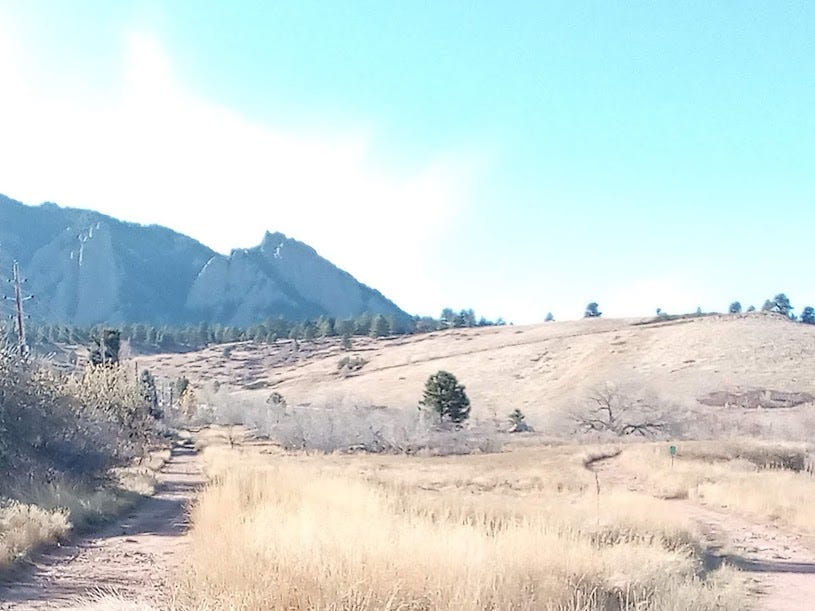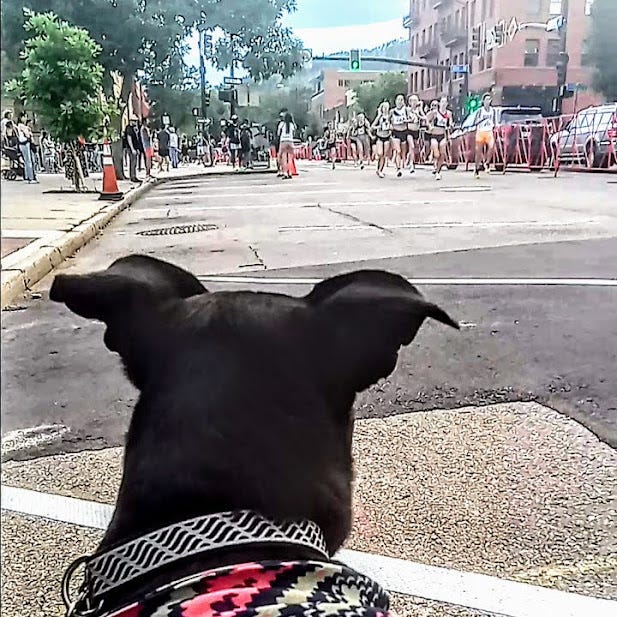What’s The Real Story With Altitude Training?
And how important is sea level training if you live in the mountains?
The article below originally appeared as a three-part series on Competitor Running Online in the summer of 2011 (I, II, III). When you see a post title consisting entirely of capitalized words, this is a signal that the post itself contains a recycled article and that I have preserved the house style of whatever entity originally published the material.
The only edits I have made to the original text, apart from oomphasizing words in accordance with my systematically ephemeral whims, are changes that reflect my combining the content into a single article (e.g., zapping “this series of articles” in favor of “this article”) and breaking up the explanation of the 1997 study I cited by Ben Levine and James Stray-Gundersen (“‘Living high-training low’: effect of moderate-altitude acclimatization with low-altitude training on performance”) into multiple paragraphs.
Also, because Competitor’s publisher had a habit of separating even short articles into multiple pages to maximize clickage, a short piece of what was originally part two of the series was never archived. I remember approximately what it said, and the presentation doesn’t suffer appreciably for its digital demise. I made a few small tweaks to what was preserved in a futile effort to avoid confusing anyone, mostly myself.
Finally, I added my own selection of photos. I took all of these myself, so feel free to use them, as well as anything that appears in them, at your leisure.
Note: The Boulder Center for Sports Medicine on the western end of Mapleton Avenue was absorbed over six years ago into the CU Sports Medicine & Performance Center next to Folsom Field a mile east of downtown.

Getting faster isn’t simply a matter of getting high and cranking out the miles.
If you’re a distance runner—even one who hasn’t left your seaside home since 1983—when you hear the term “high altitude,” you don’t even have to think about it: It’s an unqualified good thing if you can get it. It’s EPO lite, the natural way. It’s bottled oxygen without the bottle. It’s minutes off your 10K or marathon time. The Africans are born there, the best Americans congregate in places like Mammoth Lakes and Boulder and Flagstaff, and if you have the time, means and motivation, you’ll become a better, stronger, and faster distance runner after spending some time on high.
But wait. Is it really that simple? If only it were.
This article will explore a number of aspects of high-altitude training, which I will arbitrarily define as any training done at one mile (5,280′) above sea level—the altitude at which I type these lofty words—or higher. I’ll start with the physiological basics, move on to a discussion of what constitutes savvy versus unsophisticated altitude training, explore the issue of individual response to altitude, jump down to a discussion of how to take advantage of altitude gains at sea level, and finish with tips for people visiting high-altitude locations for the first time and on a limited-time basis. By the end of the piece, whatever doubts or misconceptions either one of us might have held about altitude training will hopefully have been dissolved.
Why Get High?
Why do runners and other endurance athletes move to high altitude environments in the first place? Although the scenic grandeur in such locales is usually considerable, this is not usually a motivating factor. The main reason runners head for the hills is because high-altitude air contains less oxygen than sea-level air, a situation that forces the body to compensate in a variety of ways conducive to improved distance-running performance.
Almost immediately upon moving to high altitude, your kidneys start cranking out increased amounts of erythropoetin (EPO), the hormone responsible for stimulating red blood cell (RBC) production in bone marrow. There is a lag period of about ten days before RBC levels rise, and with it, your body’s capacity for transporting oxygen from your lungs to your muscles and other tissues.
Living and training solely at high altitude is not enough to make you a faster runner. That’s a bummer, and the reason is that despite your elevated RBC count—reflected as an increase in hemoglobin and hematocrit values—you’ll experience a detraining effect. No matter how well acclimatized to high altitude you are, you can’t bang out the anaerobic speed intervals, such as repeat 400s and 800s at mile to 5K race pace, that you need in abundance as a middle-distance runner and need to a lesser degree in the long distances. This is where “live high/train low” comes into play.
Up and Down
In 1996, Benjamin Levine and James Stray-Gunderson led a team that conducted a landmark study that was published in the Journal of Applied Physiology. The researchers divided 39 highly trained runners (men with recent 5K times under 16:30 and women faster than 18:30) into three groups: a high/high group that lived and trained exclusively in Deer Valley, Utah (about 8,000’), a high/low group that lived in Deer Valley but trained in Salt Lake City (about 4,000’) and a low/low group that remained at sea level (near San Diego) for the duration of the experiment.
After a 5K time trial and a four-week normalization training period at sea level for all subjects, the groups spent four weeks in their respective environments, and then all of the runners performed sea-level 5K time trials at one, two, and three weeks post-altitude-specific training phase.
The researchers found that the high/low group significantly improved their 5K times, while the other two groups did not. This was in spite of the fact that RBC mass and VO2 Max improved by equal amounts in the high/low and high/high groups. This essentially proved that the high/low group’s ability to maintain their fastest training velocities at high heart rates was an absolute requirement for sea-level improvement in 5K performance. In other words, if you’re fast and think that altitude training is for you, then you had better find a way to live high and train low—and owing to basic geography, very few places in the United States present this as an option.
But there’s a work-around.
The Boulder Center for Sports Medicine lies at the western edge of town, in the shadow of Flagstaff Mountain. It is regarded as one of the top facilities of its kind in the United States. A glance at the newspaper clippings posted in the waiting room informs visitors that world-class runners, cyclists and triathletes darken the BCSM’s doors as often as hipsters in skinny jeans wander into the Starbucks on Pearl Street. At 9:00 on a Monday morning, the place is already busy, with clients ranging from middle-aged people in cycling garb to senior citizens maneuvering about on crutches. The BCSM is as much a rehab center for the masses as it is a haven for endurance studs.
I am greeted by Rob Pickels, one of the exercise physiologists on staff. Pickels leads me to the room where he spends most of his day, a large open space laden with all manner of exercise equipment and ancillary devices. “That’s where most of the action is,” he says, gesturing toward a men seated on a bicycle and being attended to by one of Pickels’ colleagues. The rider is being custom-fitted to ensure maximum efficiency and power when he rides outdoors. Pickels, the Ithaca College record holder in the 400-meter hurdles, is himself is on crutches, having fractured his hip two months earlier in a bicycle crash. It hasn’t dampened his enthusiasm. He leads me to a far corner of the room, where an unpretentiously ordinary treadmill sits.
“This is it,” he says. He lifts a transparent face mask, familiar to anyone who’s ever needed oxygen in an ambulance or similar setting, from its housing. “We cut holes in it so that people can breathe more easily.” The mask is connected to tubing that disappears into a console on the adjacent wall that holds a flow-rate meter and stopcock. “This connects to a general oxygen supply in the building. We set the flow rate at 15 liters a minute, they choose the speed and they’re good to go.”
The deal is this: Boulder does not lend itself to a true live high/train low scheme. Although 5,300’ is modest by high-altitude standards, getting below 4,000’ means ranging a lot farther than most people have the time or inclination to pursue. Instead, when it comes time for the high-speed repetitions or tempo runs runners have to mix into their training in order to protect their racing fitness, they come to the BCSM and use supplemental oxygen to mimic sea-level conditions. It is, in effect, the inverse of how people who live at sea level and sleep in hypoxic tents go about their training business.
I ask Pickels if non-elite runners make use of this set-up. Yes, he tells me. Not a great many, but more than a few. I remind myself that I’m in Boulder and drop the thought.
I move on to one of the more pressing questions runners considering a stint at altitude have: How long is enough? That is, what’s the minimum amount of time a runner needs to remain at high altitude in order to accrue maximum benefits and reach a plateau stage? Keeping in mind the ten-day lag between EPO production and RBC synthesis, I propose based on the fact that EPO levels return to baseline after about 25 to 28 days, five to six weeks should give runners all that they need.
Adam St. Pierre, Pickels’ colleague, answers this comprehensively. “People ask this a lot,” he says. “My answer is always, some is better than none. If you can only do seven days, then do seven days.” He notes that a lot of altitude camps run for three weeks, and proposes that because of adaptations that occur in the fourth week, extending such trips by an additional seven days is well worth it.
Pickels, meanwhile, confirms what I have long believed: that runners who do an altitude stint without the live-high/train-low aspect and still improve their performances after returning to sea level almost certainly do so as a result of simply training more than they had trained previously during their stay at elevation, where the availability of trails, training partners and favorable weather is virtually limitless.
Both physiologists offer some general advice: When you get to high altitude, take iron supplements—your body will need the extra iron for the increased hemoglobin synthesis that’s soon to follow. If you are sick when you arrive, even with a cold, don’t bother trying to take advantage of the altitude because EPO is suppressed under such conditions. Similarly, if you turn out to be among the people who develop high-elevation sickness—something unrelated to fitness that strikes genetically predisposed people idiosyncratically—quit the show and go back to the lowlands.
When I note how long it takes me to recover between short, fast intervals—400s at 3,000-meter race pace, say—Pickels mentions an interesting aspect of doing these kinds of workouts with supplemental oxygen. “Not only can you do the reps faster,” he says, “but the recovery time is much shorter, and that cuts down on the total workout time. That means you recover more quickly between workouts overall.”
This leads me to ask whether he believes that a given level of mileage run at high altitude translates into something greater at sea level. If I run 70 miles a week in Boulder, say, does that entail the physical workload of something more than that—maybe 80, 85 at sea level? Pickels agrees that it does, but whether this is merely fatiguing versus something that results in an effective training-stimulus boost is unclear.
I note drinking a great deal of water and other fluids since coming to Colorado, and that in contrast to my experience in South Florida—where prodigious sweating was the norm for 10 ½ months of the year—I didn’t necessarily feel thirsty when I theoretically should, and that I had to force myself to drink enough to stay hydrated enough to produce clear urine consistently.
Pickels again has the answer. In very dry climates such as Boulder’s, sweating is a very efficient process, meaning that only a small amount of sweat need be excreted in order to cool a running body off. This is because Boulder sweat evaporates more or less immediately on encountering the dry ambient air, unlike Fort Lauderdale sweat, which collects in gross abundance on the body because the humid air can’t accept it.
“That amount of sweat means losing a lot of electrolytes with it,” explains Pickels. “That causes a big volumetric drive to drink. We don’t have that here.” Instead, people living at high altitudes experience a lot of “insensible water loss”—water lost through the lungs and skin that can’t be seen, a situation compounded by the fact that people take more breaths at high altitude than at sea level, even at rest.
Moving on to the who raison d’etre of high-altitude training, I ask how much lead time a runner should allow between returning to sea level and racing there. Pickels recommends about two to three weeks, as this is enough to allow for a few quality speed sessions, but not enough to lose the blood-boosting benefits of high altitude. He also says that opinions about sea-level-based runners prepping for a race at altitude differ; some wait until the last minute to travel to the race site so that their training isn’t compromised, while others choose to acclimatize for several weeks.
With that, I thank my hosts and am on my way.
Conclusions
You now know what to expect if you’re considering training at high altitude or will merely be taking a ski or other trip to a high-altitude destination such as the Rockies, the Sierra Nevada or even the higher parts of the Smokies in the East. Understand that if your trip lasts less than a week, you won’t have stayed for long enough to adjust to the altitude difference, but you’ll certainly have felt the effects. Drink plenty of water, take it easy on your runs, and if you happen to find yourself in Colorado’s Front Range, enjoy the scenery.





